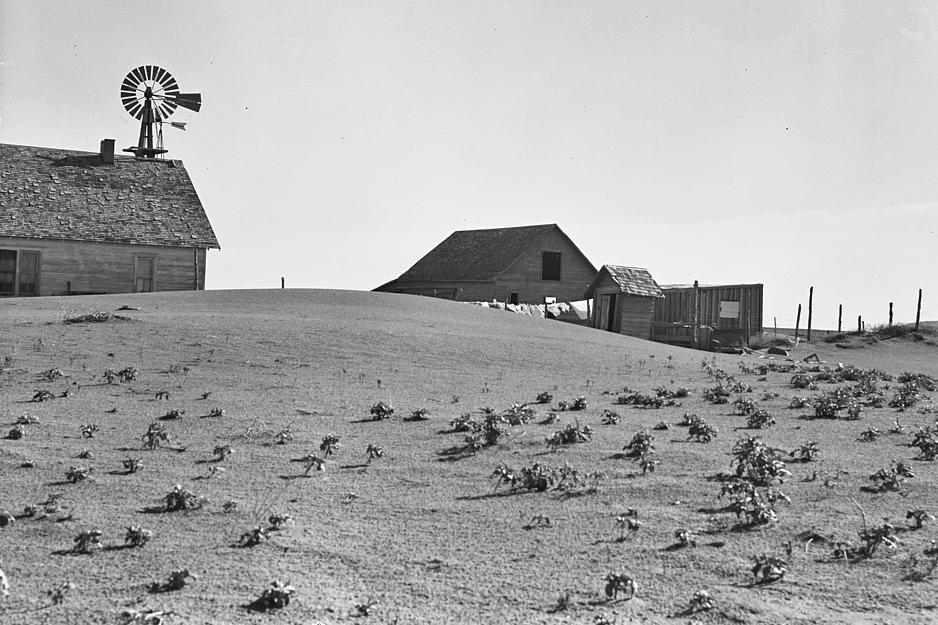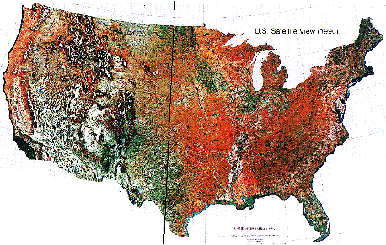

 Write for five minutes without hesitation:
Write for five minutes without hesitation: What has made the settlement of the Great Plains and especially the high plains the essential ecological story of our nation to comprehend and explain to others?
What has made the settlement of the Great Plains and especially the high plains the essential ecological story of our nation to comprehend and explain to others?A. Always there are ecological systems.
B. Because of the evidence from nature, culture, photographs, & songs.
C. Context created is crucial to comprehend this tragic unfolding of an inevitable clash of values.
There are two modes of expression:
√ writing [Latin] is literate.
√ visualization & audio-speech [Greek] is oral history.
- Let Us Now Praise Famous Men, Farm Security Administration, 1930s
- The Dust Bowl, a Ken Burns Film
The elements in the photograph are A) wind blown sand, B) sparse vegetation and absence of forests, C) six structures dwarfed by sand dunes, D) windmill, fencing and clothesline as evidence of occupants, E) big sky and extensive space, F) an absence of people comprising this homestead.
Vermont countryside in the east versus a South Dakota farmhouse during 1935, in the west.
Beyond the 100th meridian, precipitation becomes deficient for farming.

WEST --- 100th meridian --- EAST
arid ![]() humid
humid
dry deserts vs. wet prairies
"scraps of life are frozen in death."
Egan argues that " . . . the land falls into a silence that scares people . . . it scares them because the land is too . . . claustrophobic in its immensity. . . . It still scares people. . . because of the forced intimacy with a place that gives nothing back. . . a place where the land and its weather – probably the most violent and extreme on earth – demand only one thing: humility." He presses his point of view that "In those cedar posts and collapsed homes is the story of this place: how the greatest grassland in the world was turned inside out, how the crust blew away raged up into the sky and showered down a suffocating blackness off and on for more than a decade."
Worst Hard Time, pages 1-2.
conservation versus preservation
![]()
"Coldwater District, near Dalhart, Texas. This farm is occupied. Others in this area have been abandoned."
ARTHUR ROTHSTEIN FARM SECURITY ADMINISTRATION, 1930s
Egan, Timothy. The Worst Hard Time: The Untold Story of Those Who Survived the Great American Dust Bowl. Boston: Houghton Mifflin, 2006.
"On those days when the wind stops blowing across the face of the southern plains, the land falls into a silence that scares people in the way that a big house can haunt after the lights go out and no one else is there . . . . For now the narrative of those times is not just buried among the fence posts and mummified homesteads. People who lived through the whole thing –– the great town-building, farm-fattening, family establishing prosperity of the 1920s, followed by the back hand of nature in the next decade. . . –– are with us still. shelters of living memory. . . .they have a story to tell"
Causes of the Dust Bowl "In Time & Place"– on-line
James C. Malin, Grasslands of North America.
"The area of the earth's surface chosen for this study is that part of the United States designated usually as the Trans-Mississippi West. In its natural state, the feature that gave character to most of the landscape, in contrast with the area east of the Mississippi river, was the vegetational cover of grass rather than forest. Incidentally, the term natural state, as used here, means the condition in which it was found by the European at the opening of the sixteenth century."
Donald Worster, The Dust Bowl.
Worster also "reflects on the state of the plains today and the threat of a new dustbowl. He outlines some solutions that have been proposed, such as "the Buffalo Commons," where deer, antelope, bison and elk would once more roam freely, and suggests that we may yet witness a Great Plains where native flora and fauna flourish while applied ecologists show farmers how to raise food on land modeled after the natural prairies that once existed."
Paul B. Sears, Deserts on the March.
A review, The book awakened a nation to the necessity of erosion control, soil conservation through soil banking, crop rotation, contour plowing., and other restorative schemes at a time when federal policies promoted over-cropping and irrigation.
Stegner, Wallace. Beyond the Hundredth Meridian : John Wesley Powell and the Second Opening of the West.
This is an exemplary account by Stegner of a forgotten, but critical, voice in American history. That is the voice of the explorer, ethnographer, and bureau chief, John W. Powell who understood the promise of the industrial west through and despite the binding confines of geography, ecology, and water scarcity to the settlement and development of the territory between the Mississippi Valley and the Pacific Rim.